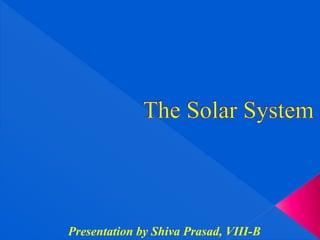
Presentation on solar system
- 1. Presentation by Shiva Prasad, VIII-B
- 2. Planets in the Solar System Planets Dwarf Planets
- 4. • Mercury is the planet nearest to the sun it has no moons. • If you weigh 100 pounds on Earth, you would only weigh 37 pounds on Mercury. • It takes less than 88 Earth days for Mercury to orbit around the sun. • 1 day lasts about 180 Earth days. • The temperature rises above 800°F while on the dark side it falls rapidly to -300°F. Mercury
- 5. • Venus, Second Planet from the Sun, Brightest Planet in Solar System. • Venus is known as Earth’s twin sister because of its similar size and proximity to each other. • Venus has a longer day than year. • It takes 243 days for Venus to make a rotation. • And it takes 224 days for Venus
- 6. • The Earth is estimated to be 4.5 billion years old. • It travels through space at 660,000 miles per hour. • The Earth weighs 6,588 10 21 tons. • The world is not round. It is an oblate spheroid, flattened at the poles and bulging at the equator. Earth (Our Home)
- 7. • Mars is the 4th closest planet to the sun. It can easily be seen from Earth . • Mars is red because it is rusty. There is a lot of iron in the soil, and the air on Mars has made it turn red. • Mars orbits the sun every 687 Earth days. • The Martian “day” is about half a hour longer than Earth. • In winter, nighttime temperature can drop as low as -191°F. Mars
- 8. • Jupiter is the largest planet in our Solar System. • Jupiter's volume is large enough to contain 1,300 planets the size of Earth. • Jupiter rotates faster than any planet in the Solar System. It rotates so quickly that the days are only 10 hours long. • But it takes 12 Earth years for Jupiter to complete an orbit around the sun. • If you weigh 100 pounds on Earth, you would weigh 264 pounds on Jupiter. Jupiter
- 9. • Saturn is the 2nd largest planet. Only Jupiter is larger. Saturn has 07 thin, flat rings around it. • The planet can be seen from Earth with the unaided eye, but its rings cannot. • It is so light that it could actually float on water if there was an ocean big enough to hold it. • It takes about 29.46 Earth Years for Saturn to orbit around our sun. • Saturn's rings are made up of billions of pieces of rocks and dust. • Saturn is a giant ball of gas, but it does have a solid inner core. • A 100 pound object on Earth would Saturn
- 10. • Uranus is the 7th planet from the sun. • Because of the strange way it spins, nights on some parts of Uranus can last for more than 40 years. • The planet's most extraordinary feature is the tilt of its rotational axis, which is almost perpendicular to the plane of the ecliptic, which means that it alternately has its north pole and its south pole turned towards the sun. • Uranus is the coldest planet in the solar system. • Uranus and Neptune are both known as Ice Giants. • It takes 30,685 Earth days for Uranus Uranus
- 11. • Neptune is so far away that it took the space probe Voyager 2, 12 years to reach it. • Neptune is the stormiest planet. The winds there can blow up to 1,240 miles per hour, that is three times as fast as Earth's Hurricanes. • Neptune is a sea blue color due to the methane gas in its atmosphere. • Neptune has 8 known moons. • Neptune is 30 times farther from the sun as is the Earth. • It goes around the sun once every 165 Earth Years. Neptune
- 12. Comets Comet is a ball of Ice and dust that makes a tail when it approaches. Comets are also leftovers from when the universe was made. All comets have nucleus, that is the ice, dust, and rock in the comet. When the comet approaches the sun, the solar energy melts the ice and vaporize. The gas form the comet make the tail. The gas also makes a cloud all over the comet called a
- 13. Asteroi ds An Asteroid is a small rocky object that is in the solar system. Many of the asteroids in the solar system in orbiting the sun between Mars and Jupiter called the asteroid belt. Asteroids are rocky fragments left over from the formation of the solar system about 4.6 billion years ago.
- 14. Meteor • A meteor is a small ball of light that appears in the night sky briefly. • It is also called Shooting star. • Some wish a pone the meteor and make a wish. • It is said that if you wish on a shooting star your wish will come true. • The meteoroid when it falls down into the earth atmosphere it burns up into a meteor or a shooting star.
- 15. Meteori te • A meteorite is a small chunk of metal or rock that falls down to earth or any other planet. • An iron meteorite weighing some 60,000 kg is the largest meteorite ever found. It still lies where it was found in 1920 at Hoba Farm, near Grootfontein, Namibia. Surprisingly, there is no crater, because the meteorite entered the atmosphere at a long, shallow angle and was slowed down by the atmospheric drag.
